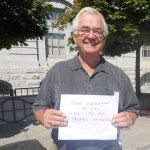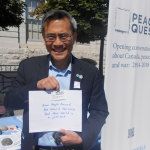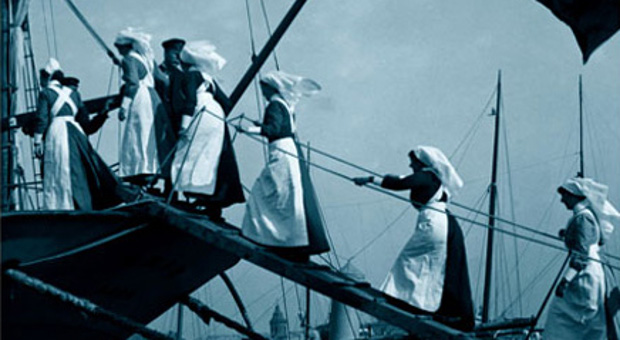April 26th: Testament of Youth Discussion Questions
You definitely don’t need to read the book to benefit from this great presentation! Read on below for Patricia Rae’s discussion questions to get you started before the event. This story was recently adapted into a film in 2014 and the BBC Miniseries from 1979 can be found on YouTube.
Vera Brittain’s Testament of Youth: PeaceQuest, April 26, 2015
Discussion questions
Patricia Rae, Queen’s University
We’ll be looking at Vera Brittain’s 1933 memoir as an example of the genre of the “grief memoir”: that is, as a book that recounts an experience of personal loss and charts a way through what Freud called the “work of mourning.” In Brittain’s case, the loss was owed to the trench warfare of World War I, a catastrophe into which she felt her generation had stumbled blindly. The “work of mourning” leads her not only to write the memoir, in which she attempts to caution a new generation against going to war again, but to decades of work as one of Britain’s most prominent peace activists.
My hope is that the following questions highlight issues of interest to contemporary peace activists, and that members of the PeaceQuest community will feel welcome to participate in discussion even if they haven’t yet had a chance to read Brittain’s memoir. For the sake of shaping our conversation in a meaningful and inclusive way, I’ve organized them into two broad areas of concern: what Brittain teaches us about motives for and impediments to peace-work.
From grief to peace-work
Like other forms of grief, the loss of loved ones to war activates “elegiac” discourse, whose purpose is to console. Many war writers, however, struggle with consolatory discourse, sensing that it can lead to more war and more suffering. “Anti-elegiac” writers like Wilfred Owen, Siegfried Sassoon, and, perhaps, Vera Brittain, sense that it is better to resist consolation, or to deny comfort to their readers. We’ll start by looking at what Testament of Youth has to say about this important dichotomy.
- Elegy in the air: the soldier as Christ. In the poetry she reads (and writes), in the services she attends and the memorials she visits, Vera reminds us of several common elegiac consolations for wartime losses. For instance, she reads Shelley’s famous pastoral elegy for Keats, “Adonais,” and she recalls being at chapel and being stirred by “a large contingent of the Oxford and Bucks Light Infantry singing, in their vigorous young voices, “The Son of God goes forth to War” (TY 147). The tradition of “pastoral” elegy to which “Adonais” belongs draws consolation from natural cycles of death and rebirth. The analogy between soldiers and Christ, such as the one in the hymn, was very common in consolatory discourse in Britain and her colonies during the First World War and also invokes the promise of rebirth after death. What do you make of such consolatory strategies? Does Vera encourage you to accept or reject them?
- Vera as anti-elegist, refusing consolation. After he has been at the front for a while, Vera’s lover, Roland Leighton, formulates some “anti-elegiac” responses to the war, targeting especially the comfort provided by beauty – flowers, sunsets, and so on (TY 135, 172). Some argue that Vera’s memoir belongs with the anti-elegiac literature on the war, for instead of covering up the horrors of pain, suffering, and death, it offers visceral descriptions of these things, which Vera witnessed as a nurse. She also lingers on her own sorrow, or melancholia, in the wake of Roland’s death.
With these details, Vera appears to be repudiating Freud’s famous advice to mourners to “heal their wounds” and “move on” from their suffering, Although her “refusal of consolation” aligns her with famous anti-elegists like Owen and Sassoon, it also links Vera to a long tradition of female mourners, from Sophocles’ Antigone to the “Mothers of the Disappeared” in Argentina. Refusing the state’s offer to commemorate the sons it has murdered, the Madres expressed their commitment to resisting consolation this way:
Let there be no healing of wounds. Let them remain open. Because if the wounds still bleed, there will be no forgetting and our strength will continue to grow. (Madres)
What are the pros and cons for a would-be peace activist of “leaving the wounds open,” both for herself and for her audience?
- Russell vs. Benson. On pp. 248-249, Vera contrasts two texts representing two different responses to grief: Benson’s “Prayer after a Crushing Bereavement” and a statement from Bertrand Russell’s The Conquest of Happiness. While she sees some merit in both passages, ultimately it is Russell’s she endorses. Here, for reference, is Russell:
A man of adequate vitality and zest will surmount all misfortunes by the emergence after each blow of an interest in life and the world which cannot be narrowed down to much as to make one loss fatal. To be defeated by one loss . . . is not something to be admired as a proof of sensibility, but something to be deplored as a failure in vitality. All our affections are at the mercy of death, which may strike down those whom we love at any moment. It is therefore necessary that our lives should not have that narrow intensity which puts the whole meaning and purpose of our life at the mercy of accident. (249)
What does Russell mean by rejecting “that narrow intensity which puts the whole meaning and purpose of our life at the mercy of accident”? What part of his position inspires Vera? Is it a useful policy for peace activists?
- “Ethical mourning” (Spargo). Seeking an alternative way of mourning somewhere between Freud’s “moving on” and crippling melancholia, the contemporary critic R. Clifton Spargo has defined an alternative response to grief he calls “ethical mourning.” Inspired by the work of Emmanuel Levinas, this is the policy of “keeping the wound open” but, instead of wallowing in sorrow, thinking always about others. More specifically, the “ethical mourner” feels a sense of “retroactive responsibility” towards the dead and devotes herself to preventing such harm from coming to others in the future. (See Spargo, The Ethics of Mourning: Grief and Responsibility in Elegiac Literature (2004)) Spargo’s formulation is very close to Vera’s explanation of why she commits herself to working for peace: see, for instance, p. 471.
What do you think about “ethical mourning” as a model for grieving and a motive for peace work? What benefits does it promise and what problems?
Some impediments to peace-work, and some proposed solutions
- Malta and the romance of war. Vera’s experiences nursing in Malta remind us that war didn’t just bring sorrow to women, but also new opportunities to work and travel. She is unsparing in her descriptions of the “strange nostalgia” her memories of that time evoke in her. “Malta remains in my recollection,” she says, “as an interval of heaven, a short year of glamorous beauty and delights . . .”(TY 290). She sums up its effects most vividly on p. 291:
The place has become for me a shrine, the object of a pilgrimage, a fairy country which I know that I must see again before I die. Looking back through the years to sun-filled memory pictures of golden stone buildings, of turquoise and sapphire seas, of jade and topaz and amethyst skies, of long stretches of dust-white road winding seaward over jagged black rocks older than history, I am filled with yearning and regret, and I cry in my heart: Come back, magic days! I was sorrowful, anxious, frustrated, lonely—but yet how vividly alive!
The poem heading up Chapter VII (“We Shall Come No More”) expresses similar intense nostalgia for that place.
Does all this nostalgia work against the pacifist message of the memoir? What do you make of Vera’s point on p. 292 that the “glamour” and “magic” of war is “the pacifist’s real problem”? What steps might peace activists take to counter the powerful allure of war?
- Communicating across generations: a problem and some solutions
- a) When Vera returns to Oxford after the war, she encounters problems with the slightly younger women she meets there who do not share her wartime experience (TY 488-493). These intergenerational tensions are not confined to women (see 497) What do you make of this tension? What is its source and what perils does it represent?
- b) Consider some of the strategies Vera deploys in her memoir for reaching across generations. Notice for instance her use of “temporal layering” in the text (e.g. 111, 86, 89), and also her frequent references to souvenirs ( 522, 527, 533-34). Are these useful models for writers (and others) working for peace? What are some other good strategies for overcoming the problem of generations and generational memory when it comes to war?
—
These questions should give us more than enough to discuss, but if we have time those who have worked their way to the end of the memoir might consider one more thing.
Describing the manuscript of Testament of Youth to her husband, George Catlin, Vera writes that “my method throughout this book has been to illustrate the tragedies of Europe and the story of our generation by the fortuitous symbolism of the events in my own life.” She says that her eventual marriage to Catlin marks her “resurrection from the spiritual death of the war,” saying that it models a kind of rebirth Europe as a whole might follow.
What do you make of this? Is it arrogance? A reversion to romantic love at odds with Vera’s feminism? Or does Vera’s personal growth, as recorded in the memoir and reflected in her marriage, really serve as a productive model for others in early 1930s Europe?










